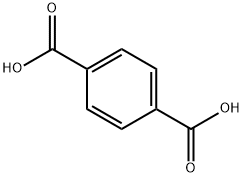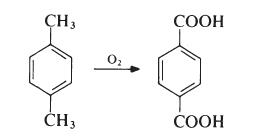
Терефталевая кислота
- английское имяTerephthalic acid
- CAS №100-21-0
- CBNumberCB8852557
- ФормулаC8H6O4
- мольный вес166.13
- EINECS202-830-0
- номер MDLMFCD00002558
- файл Mol100-21-0.mol
| Температура плавления | >300 °C (lit.) |
| Температура кипения | 214.32°C (rough estimate) |
| плотность | 1.58 g/cm3 at 25 °C |
| давление пара | <0.01 mm Hg ( 20 °C) |
| показатель преломления | 1.5100 (estimate) |
| Fp | 260°C |
| температура хранения | Sealed in dry,Room Temperature |
| растворимость | 15mg/l (experimental) |
| форма | Crystalline Powder |
| пка | 3.51(at 25℃) |
| цвет | White |
| РН | 3.36(1 mM solution);2.79(10 mM solution);2.26(100 mM solution) |
| Растворимость в воде | slightly soluble in water (0,017 g/L at 25°C) |
| Мерк | 14,9162 |
| БРН | 1909333 |
| Пределы воздействия | ACGIH: TWA 10 mg/m3 |
| Диэлектрическая постоянная | 1.5(Ambient) |
| Стабильность | Stable. Combustible. Incompatible with strong oxidizing agents. |
| LogP | 2 at 25℃ |
| Справочник по базе данных CAS | 100-21-0(CAS DataBase Reference) |
| Непрямые добавки, используемые в веществах, контактирующих с пищевыми продуктами | TEREPHTHALIC ACID |
| Рейтинг продуктов питания EWG | 1 |
| FDA UNII | 6S7NKZ40BQ |
| Система регистрации веществ EPA | Terephthalic acid (100-21-0) |
| UNSPSC Code | 85151701 |
| NACRES | NA.24 |
| Коды опасности | Xi | |||||||||
| Заявления о рисках | 36/37/38 | |||||||||
| Заявления о безопасности | 26-36 | |||||||||
| WGK Германия | 3 | |||||||||
| RTECS | WZ0875000 | |||||||||
| Температура самовоспламенения | 925 °F | |||||||||
| TSCA | Yes | |||||||||
| кода HS | 2917 36 00 | |||||||||
| Банк данных об опасных веществах | 100-21-0(Hazardous Substances Data) | |||||||||
| Токсичность | LD50 orally in Rabbit: > 6400 mg/kg | |||||||||
| NFPA 704: |
|
рисовальное письмо(GHS)
-
рисовальное письмо(GHS)

-
сигнальный язык
опасность
-
вредная бумага
H315:При попадании на кожу вызывает раздражение.
H319:При попадании в глаза вызывает выраженное раздражение.
H335:Может вызывать раздражение верхних дыхательных путей.
-
оператор предупредительных мер
P261:Избегать вдыхания пыли/ дыма/ газа/ тумана/ паров/ аэрозолей.
P264:После работы тщательно вымыть кожу.
P304+P340:ПРИ ВДЫХАНИИ: Свежий воздух, покой.
P305+P351+P338:ПРИ ПОПАДАНИИ В ГЛАЗА: Осторожно промыть глаза водой в течение нескольких минут. Снять контактные линзы, если Вы ими пользуетесь и если это легко сделать. Продолжить промывание глаз.
P332+P313:При возникновении раздражения кожи: обратиться за медицинской помощью.
P337+P313:Если раздражение глаз не проходит обратиться за медицинской помощью.
P405:Хранить в недоступном для посторонних месте.
Терефталевая кислота химические свойства, назначение, производство
Описание
Terephthalic acid is the organic compound with formula C6H4(COOH)2. This colourless solid is a commodity chemical, used principally as a precursor to the polyester PET, used to make clothing and plastic bottles. Several million tones are produced annually. It is one of three isomeric phthalic acids.Химические свойства
Terephthalic acid is a white crystalline solid. Soluble in alkaline solution, slightly soluble in hot ethanol, insoluble in water, ether, glacial acetic acid and chloroform, consequently up until around 1970 most crude terephthalic acid was converted to the dimethyl ester for purification. It sublimates when heated.История
Terephthalic acid came to prominence through the work of Winfield and Dickson in Britain around 1940. Earlier work by Carothers and coworkers in the United States established the feasibility of producing high molecular weight linear polyesters by reacting diacids with diols, but they used aliphatic diacids and diols. These made polyesters which were unsuitable to be spun into fibers. Winfield and Dickson found that symmetrical aromatic diacids yield high-melting, crystalline, and fiberforming materials; poly(ethylene terephthalate) (PET) has since become the largest volume synthetic fiber.Использование
Terephthalic acid (TPA) is a benzenepolycarboxylic acid with potential anti-hemorrhagic properties. It is a high-tonnage chemical, widely used in the production of synthetic materials, notably polyester fibers (poly-(ethylene terephthalate)).прикладной
1,4-benzenedicarboxylic acid is mainly used for the production of poly (ethylene terephthalate). Also production of plasticizer dioctyl phthalate (DOTP) and polyester plasticized agents. 1,4-benzenedicarboxylic acid and polyhydric alcohols have a condensation reaction withd iethylene glycol, triethylene glycol, glycerol, propylene glycol, butylene glycol, etc. preparation of the polyester plasticizer.Подготовка
The major commercial route to terephthalic acid which is suitable for the direct preparation of poly(ethylene terephthalate) is from p-xylene:
p-Xylene is obtained largely from petroleum sources, being a product of the fractionation of reformed naphthas. The oxidation is carried out in the liquid phase. Typically, air is passed into a solution of p-xylene in acetic acid at about 200?? and 2 MPa (20 atmospheres) in the presence of a catalyst system containing cobalt and manganese salts and a source of bromide ions. The terephthalic acid produced contains only small amounts of impurities (mainly p-carboxybenzaldehyde), which are readily removed. The acid is dissolved in water at about 2500 e and 5 MPa (50 atmospheres) and treated with hydrogen (which converts the aldehyde to p-toluic acid). The solution is then cooled to 100?? and pure terephthalic acid crystallizes.
прикладной
Virtually the entire world's supply of terephthalic acid and dimethyl terephthalate are consumed as precursors to polyethylene terephthalate (PET). World production in 1970 was around 1.75 million tones. By 2006, global purified terephthalic acid (PTA) demand had exceeded 30 million tonnes.There is a smaller, but nevertheless significant, demand for terephthalic acid in the production of poly butylene terephthalate and several other engineering polymers.
Методы производства
Terephthalic acid is produced by oxidation of p-xylene by oxygen in air:This reaction proceeds through a p-toluic acid intermediate which is then oxidized to terephthalic acid. In p-toluic acid, deactivation of the methyl by the electron withdrawing carboxylic acid group makes the methyl one tenth as reactive as xylene itself, making the second oxidation significantly more difficult . The commercial process utilizes acetic acid as solvent and a catalyst composed of cobalt and manganese salts, with a bromide promoter.
Определение
ChEBI: Terephthalic acid is a benzenedicarboxylic acid carrying carboxy groups at positions 1 and 4. One of three possible isomers of benzenedicarboxylic acid, the others being phthalic and isophthalic acids. It is a conjugate acid of a terephthalate(1-).Общее описание
White powder.Реакции воздуха и воды
Insoluble in water.Профиль реактивности
Terephthalic acid is a carboxylic acid. Terephthalic acid donates hydrogen ions if a base is present to accept them. This "neutralization" generates substantial amounts of heat and produces water plus a salt. Insoluble in water but even "insoluble" carboxylic acids may absorb enough water from the air and dissolve sufficiently in Terephthalic acid to corrode or dissolve iron, steel, and aluminum parts and containers. May react with cyanide salts to generate gaseous hydrogen cyanide. Will react with solutions of cyanides to cause the release of gaseous hydrogen cyanide. Flammable and/or toxic gases and heat are generated by reaction with diazo compounds, dithiocarbamates, isocyanates, mercaptans, nitrides, and sulfides. React with sulfites, nitrites, thiosulfates (to give H2S and SO3), dithionites (SO2), to generate flammable and/or toxic gases and heat. Reaction with carbonates and bicarbonates generates a harmless gas (carbon dioxide) but still heat. Can be oxidized by strong oxidizing agents and reduced by strong reducing agents. These reactions generate heat. May initiate polymerization reactions; may catalyze (increase the rate of) chemical reactions.Пожароопасность
Flash point data for Terephthalic acid are not available. Terephthalic acid is probably combustible.Профиль безопасности
Moderately toxic by intravenous and intraperitoneal routes. Mildly toxic by ingestion. An eye irritant, Can explode during preparation. When heated to decomposition it emits acrid smoke and irritating fumes.Возможный контакт
TPA is used primarily in the production of polyethylene terephthalate polymer for the fabrication of polyester fibers and films. A high-volume production chemical in the United States.Методы очистки
Purify the acid via the sodium salt which, after crystallisation from water, is re-converted to the acid by acidification with mineral acid. Filter off the solid, wash it with H2O and dry it in a vacuum. The S-benzylisothiuronium salt has m 204o (from aqueous EtOH). [Beilstein 9 IV 3301.]Несовместимости
Combustible; dust may form an explosive mixture with air. Compounds of the carboxyl group react with all bases, both inorganic and organic (i.e., amines) releasing substantial heat, water and a salt that may be harmful. Incompatible with arsenic compounds (releases hydrogen cyanide gas), diazo compounds, dithiocarbamates, isocyanates, mercaptans, nitrides, and sulfides (releasing heat, toxic and possibly flammable gases), thiosulfates and dithionites (releasing hydrogen sulfate and oxides of sulfur). Incompatible with oxidizers (chlorates, nitrates, peroxides, permanganates, perchlorates, chlorine, bromine, fluorine, etc.); contact may cause fires or explosions. Keep away from alkaline materials, strong bases, strong acids, oxoacids, epoxides.Утилизация отходов
Dissolve or mix the material with a combustible solvent and burn in a chemical incinerator equipped with an afterburner and scrubber. All federal, state, and local environmental regulations must be observed.Терефталевая кислота запасные части и сырье
сырьё
1of3
запасной предмет
- liquid crystalline heterocyclic polymer
- Poly(butylene terephthalate)
- tussah silk fabric aftertreatment finishing agent
- 3-аминофталгидразид
- Unsaturated polyester resin
1of3
Терефталевая кислота поставщик
| поставщик | телефон | страна | номенклатура продукции | благоприятные условия | |
|---|---|---|---|---|---|
| +8618660799346 | China | 1009 | 58 | ||
| +8615531157085 | China | 8804 | 58 | ||
| +86 13288715578 +8613288715578 |
China | 12825 | 58 | ||
| +86-13131129325 | China | 5887 | 58 | ||
| +8617732866630 | China | 18147 | 58 | ||
| +86-15532196582 +86-15373005021 |
China | 3007 | 58 | ||
| +16837774622 | China | 295 | 58 | ||
| +8615713292910 | China | 341 | 58 | ||
| +86-86-1913198-3935 +8617331935328 |
China | 970 | 58 | ||
| +8613343047651 | China | 3692 | 58 |